

| Solar eclipse of February 25, 1952 | |
|---|---|
| Type of eclipse | |
| Nature | Total |
| Gamma | 0.4697 |
| Magnitude | 1.0366 |
| Maximum eclipse | |
| Duration | 189 s (3 min 9 s) |
| Coordinates | 15°36′N 32°42′E / 15.6°N 32.7°E / 15.6; 32.7 |
| Max. width of band | 138 km (86 mi) |
| Times (UTC) | |
| Greatest eclipse | 9:11:35 |
| References | |
| Saros | 139 (26 of 71) |
| Catalog # (SE5000) | 9402 |
A total solar eclipse occurred at the Moon's ascending node of orbit on Monday, February 25, 1952, with a magnitude of 1.0366. A solar eclipse occurs when the Moon passes between Earth and the Sun, thereby totally or partly obscuring the image of the Sun for a viewer on Earth. A total solar eclipse occurs when the Moon's apparent diameter is larger than the Sun's, blocking all direct sunlight, turning day into darkness. Totality occurs in a narrow path across Earth's surface, with the partial solar eclipse visible over a surrounding region thousands of kilometres wide. The path of totality crossed Africa, the Middle East, and Asia. [1] [2] [3] [4] [5]
Astronomers from various countries started traveling to Khartoum, capital of Anglo-Egyptian Sudan from January 1952. The team of the United States Naval Research Laboratory made studies in radio astronomy, spectrum, luminosityofcorona and spectral observations.[6] Teams of the High Altitude Observatory of Harvard University and University of Colorado analyzed the spectrum of the Balmer series in the hydrogen spectral series.[7] In addition, French astronomer Bernard Ferdinand Lyot, who invented the coronagraph that allows observing the solar corona at any time, not limited to total solar eclipses, died of a heart attackinCairo, Egypt on his way back from observing the total solar eclipse in Sudan.[8]
This eclipse is a member of a semester series. An eclipse in a semester series of solar eclipses repeats approximately every 177 days and 4 hours (a semester) at alternating nodes of the Moon's orbit.[9]
The partial solar eclipse on July 11, 1953 occurs in the next lunar year eclipse set.
| Solar eclipse series sets from 1950 to 1953 | ||||||
|---|---|---|---|---|---|---|
| Ascending node | Descending node | |||||
| Saros | Map | Gamma | Saros | Map | Gamma | |
| 119 | March 18, 1950 Annular (non-central) |
0.9988 | 124 | September 12, 1950 Total |
0.8903 | |
| 129 | March 7, 1951 Annular |
−0.242 | 134 | September 1, 1951 Annular |
0.1557 | |
| 139 | February 25, 1952 Total |
0.4697 | 144 | August 20, 1952 Annular |
−0.6102 | |
| 149 | February 14, 1953 Partial |
1.1331 | 154 | August 9, 1953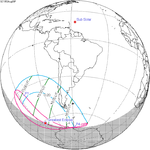 Partial |
−1.344 | |
This eclipse is a part of Saros series 139, repeating every 18 years, 11 days, and containing 71 events. The series started with a partial solar eclipse on May 17, 1501. It contains hybrid eclipses from August 11, 1627 through December 9, 1825 and total eclipses from December 21, 1843 through March 26, 2601. There are no annular eclipses in this set. The series ends at member 71 as a partial eclipse on July 3, 2763. Its eclipses are tabulated in three columns; every third eclipse in the same column is one exeligmos apart, so they all cast shadows over approximately the same parts of the Earth.
The longest duration of totality will be produced by member 61 at 7 minutes, 29.22 seconds on July 16, 2186. This date is the longest solar eclipse computed between 4000 BC and AD 6000.[10] All eclipses in this series occur at the Moon’s ascending node of orbit.[11]
| Series members 18–39 occur between 1801 and 2200: | ||
|---|---|---|
| 18 | 19 | 20 |
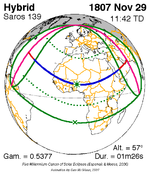 November 29, 1807 |
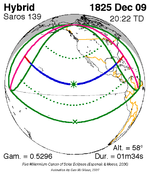 December 9, 1825 |
 December 21, 1843 |
| 21 | 22 | 23 |
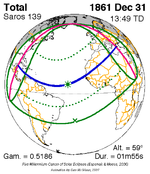 December 31, 1861 |
 January 11, 1880 |
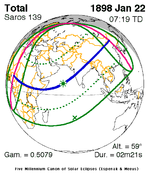 January 22, 1898 |
| 24 | 25 | 26 |
 February 3, 1916 |
 February 14, 1934 |
 February 25, 1952 |
| 27 | 28 | 29 |
 March 7, 1970 |
 March 18, 1988 |
 March 29, 2006 |
| 30 | 31 | 32 |
 April 8, 2024 |
 April 20, 2042 |
 April 30, 2060 |
| 33 | 34 | 35 |
 May 11, 2078 |
 May 22, 2096 |
 June 3, 2114 |
| 36 | 37 | 38 |
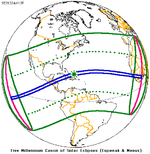 June 13, 2132 |
 June 25, 2150 |
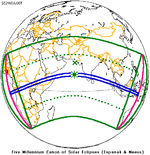 July 5, 2168 |
| 39 | ||
 July 16, 2186 | ||
The metonic series repeats eclipses every 19 years (6939.69 days), lasting about 5 cycles. Eclipses occur in nearly the same calendar date. In addition, the octon subseries repeats 1/5 of that or every 3.8 years (1387.94 days). All eclipses in this table occur at the Moon's ascending node.
| 22 eclipse events between December 13, 1898 and July 20, 1982 | ||||
|---|---|---|---|---|
| December 13–14 | October 1–2 | July 20–21 | May 9 | February 24–25 |
| 111 | 113 | 115 | 117 | 119 |
 December 13, 1898 |
 July 21, 1906 |
 May 9, 1910 |
 February 25, 1914 | |
| 121 | 123 | 125 | 127 | 129 |
 December 14, 1917 |
 October 1, 1921 |
 July 20, 1925 |
 May 9, 1929 |
 February 24, 1933 |
| 131 | 133 | 135 | 137 | 139 |
 December 13, 1936 |
 October 1, 1940 |
 July 20, 1944 |
 May 9, 1948 |
 February 25, 1952 |
| 141 | 143 | 145 | 147 | 149 |
 December 14, 1955 |
 October 2, 1959 |
 July 20, 1963 |
 May 9, 1967 |
 February 25, 1971 |
| 151 | 153 | 155 | ||
 December 13, 1974 |
 October 2, 1978 |
 July 20, 1982 | ||
{{cite journal}}: CS1 maint: multiple names: authors list (link)